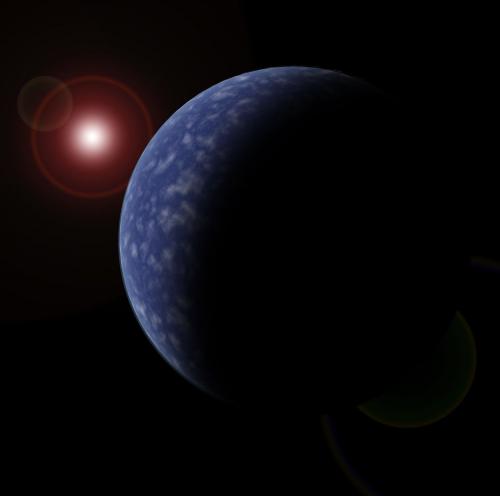Every red dwarf star has at least one planet
The news is that every M dwarf probably has at least 1 planet, if not more, which is good news when looking for cosmic real estate. The bad news – as blogged here previously – is that exoplanets bigger than Earth, or even Earth-sized and unlucky, are unable to rid themselves of the primordial H/He atmosphere they capture while forming. Too big means the planet becomes a mini-Neptune.
The relevant preprint is here: Bayesian search for low-mass planets around nearby M dwarfs: Estimates for occurrence rate based on global detectability statistics
One of the systems identified is a two-planet system around the star GJ 682. The planets are Super-Earths, though the uncertainty range goes as low as 2 Earth-masses for the habitable zone planet. Being radial velocity measurements, the odds are it’s a Sub-Neptune massing ~4 Earths. Intriguingly GJ 682 is only 16.6 ly away, so we should probably add the planet to the list of “Nearby Habitable Zone Planets” even if it is a sub-Neptune.
An atmosphere of H/He can be an asset for an anoxic (oxygen-less) biosphere for planets further out from their stars, though too much primordial atmosphere means a very large greenhouse effect trapping geothermal heat in. For example, Earth emits ~0.08 W per square metre, on average. Thus, with no stellar input, its equilibrium temperature is ~34.5 K. With an adiabatic atmosphere holding the heat in, and a photospheric temperature of 34.5 K, then the critical point of water (647.3 K) is exceeded at a surface pressure of ~5742 bar. A convenient measure of total H/He is “Earth Ocean Equivalents (Hydrogen)” (EOEH) – in Earth’s case there’s 1.5E+20 kg of hydrogen in our oceans, the equivalent of 29.4 bar surface pressure. Thus >200 EOEHs would mean no liquid water is possible. Bigger planets would have higher radiogenic and cosmogonic heat-fluxes, roughly increasing with the 1/2 root of the mass. A 10 Earth-mass planet would have a photospheric temperature of ~46 K, but it’d also have a higher gravity, but a higher surface area to spread a given mass of atmosphere over too. For Super-Earths the surface pressure produced by a given atmosphere mass at the surface of the solid core decreases slowly with planet mass (a ~-0.1 power, roughly). So >90 EOEHs would broil a 10 Earth-mass Super-Earth.
Sounds like a lot, but even 200 EOEHs is only 0.5% the mass of the Earth. Not a lot of hydrogen, by proportion, will mean death for an otherwise Earth-like planet.

